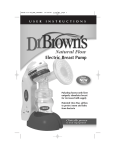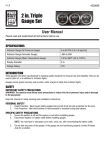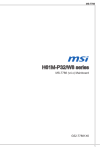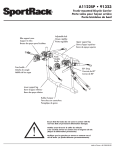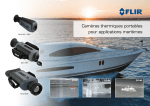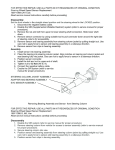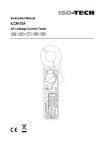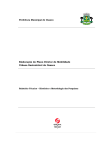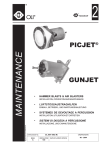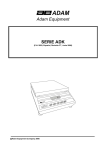Download instructions for the installation and operation of controls
Transcript
2:05 PM Page 1 CONTROLS OUTPUT CONTROL SETUP The Sync setting is shown as 10 through 90 with 10 being the least aggressive and 90 being the most aggressive. With the trailer connected press and hold the brake pedal, the Display will show the Output setting. The Sync adjustment has no effect on the manual control. MORE OUTPUT LESS OUTPUT PUSH TO APPLY BRAKES SYNC CONTROL pedal (trailer must be connected) and move the Sync Control slightly. The display will change to the Sync mode. OUTPUT / SYNC DISPLAY MANUAL CONTROL The Sync Control would be adjusted for individual driver preference or changing road conditions. MANUAL CONTROL The Manual Control is located on the front of the Brake Control Unit at the right side. MORE AGGRESSIVE BRAKING LESS AGGRESSIVE BRAKING OUTPUT CONTROL The Output Control establishes the maximum amount of power available to the trailer brakes. As the Control is rotated up more power will be available to the brakes when the brake pedal is pressed or the manual control is used. The Output Control would be adjusted during initial setup, when trailer load changes, when different trailers are used or to adjust for a change in road conditions. The Output setting is shown on the digital display when a trailer is connected and the brake pedal is pressed or the Manual Control is actuated. The Output setting is shown as 0 through 10 with 0 being the minimum and 10 the maximum. The Manual Control only applies the trailer brakes and would be used during initial setup and in situations where it is desirable to reduce speed slowly. When the Manual Control is pushed to the left, the control begins to apply the trailer brakes. The further to the left it is pushed the harder the brakes are applied until the maximum set by the Output Control is reached. The Output setting will be shown on the display and can be adjusted when using the Manual Control. The Manual Control activates the tow vehicle and trailer stoplights. SINGLE DECIMAL CONTROL ACTIVATED NO TRAILER CONNECTED LEVEL OUTPUT DISPLAY CONTROL ACTIVATED TRAILER CONNECTED The Sync Control adjusts trailer brake aggressiveness. The trailer brakes become more aggressive as the switch is moved toward the front of the tow vehicle. To view the Sync setting on the display, press the brake ERROR DISPLAY INTERNAL CONTROL ERROR SEE TROUBLE SHOOTING GUIDE LEVEL SYNC CONTROL The Sync Control is located on the left side of the Brake Control Unit, forward of the mounting bracket. LEVEL LEVEL SYNC DISPLAY BRAKE PEDAL PUSHED SYNC CONTROL ACTIVATED TRAILER CONNECTED OVER LOAD DISPLAY SHORTED OR OVER LOADED BRAKE CIRCUIT SEE TROUBLE SHOOTING GUIDE LEVEL DISPLAY MODES DIGITAL DISPLAY The Digital display shows the Output setting when the control is activated. It is used to setup and monitor the Brake Control and can be used when trouble shooting. TROUBLE SHOOTING GUIDE Preliminary Adjustments Adjust to 2.0 by turning the control up or down as needed. While still holding the brake pedal move the Sync Control slightly, the Display will change to the Sync setting. Adjust to 40 by sliding the Sync Control ahead or back as necessary. TEST DRIVE In an open area, such as a large parking lot, drive forward and apply the trailer brakes using the Manual Control. If the trailer brakes are weak adjust the Output Control up. If the trailer brakes jerk or lockup adjust the Output Control down. Repeat this step until firm braking is felt with out jerking or lockup. Once the Output is set, drive forward and press the brake pedal, the tow vehicle and trailer should make a smooth stop. If the stop seems slow and more aggressive braking is desired, move the Sync Control rearward while holding the brake pedal. If the stop seems too aggressive adjust the Sync Control rearward while holding the brake pedal. After making a Sync adjustment the Display will show the setting until the brake pedal is released. Make several stops at various speeds and adjust the Sync until stops are smooth and firm. Slight adjustment of the Output Control may also be desirable. NOTE: If any problems occur during Setup refer to the Trouble Shooting section of these instructions. TEST WITHOUT TRAILER FIRST CONDITION WITHOUT TRAILER CONNECTED 3/6/03 WITH TRAILER CONNECTED 05500-037 2/6/03 English DISPLAY DECIMAL POINT DOES NOT LIGHT WHEN BRAKE PEDAL OR MANUAL CONTROL IS USED DECIMAL POINT DOES NOT LIGHT WHEN BRAKE PEDAL IS PUSHED DOES LIGHT WITH MANUAL DECIMAL ON ALL THE TIME LEVEL BLANK LEVEL LEVEL PEDAL MANUAL LEVEL DECIMAL ONLY DISPLAY SHOWS OUTPUT SETTING DISPLAY SHOWS OL WHEN ACTIVATED DISPLAY SHOWS Er LEVEL PROBABLE CAUSES POSSIBLE SOLUTION NO POWER TO CONTROL, NO GROUND, REVERSED BLACK AND WHITE WIRES, CIRCUIT BREAKER BLOWN CHECK AND REPAIR CONNECTIONS REFER TO "WIRING" SECTION NO CONNECTION OR INCORRECT CONNECTION AT STOPLIGHT SWITCH, BLOWN FUSE IN STOPLIGHT CIRCUIT CHECK AND REPAIR CONNECTIONS REFER TO "WIRING" SECTION, CHECK STOPLIGHT CIRCUIT RED WIRE CONNECTED TO THE WRONG SIDE OF THE STOPLIGHT SWITCH OR TO WRONG SWITCH (CRUISE CONTROL) CHECK AND REPAIR CONNECTIONS REFER TO "WIRING" SECTION BRAKE CONTROL UNIT MISWIRED CHECK AND REPAIR CONNECTIONS REFER TO "WIRING" SECTION SHORT IN BLUE WIRE CIRCUIT LOCATE AND CORRECT SHORT INTERNAL BRAKE CONTROL PROBLEM RETURN UNIT TO DEALER FOR EVALUATION NO CONNECTION BETWEEN BRAKE CONTROL AND BRAKES - BLUE WIRE CIRCUIT CONFIRM CONNECTION TO TRAILER CONNECTOR, CONFIRM CONNECTOR TERMINAL POSITIONS, CHECK TRAILER MISWIRED TRAILER CONNECTOR CONFIRM TRAILER CONNECTOR TERMINAL POSITIONS OUTPUT SETTING LEVEL LEVEL LEVEL DECIMAL ONLY NO TRAILER BRAKES, PEDAL OR MANUAL ELECTRONIC TRAILER BRAKE CONTROL FOR 2, 4, 6 & 8 BRAKE SYSTEMS FLASHING OL ERROR NO TRAILER BRAKES, PEDAL OR MANUAL INSTRUCTIONS FOR THE INSTALLATION AND OPERATION OF LEVEL IMPORTANT: READ AND FOLLOW THESE INSTRUCTIONS CAREFULLY. KEEP THESE INSTRUCTIONS IN YOUR TOW VEHICLE FOR FUTURE REFERENCE. OUTPUT SETTING NO TRAILER BRAKES, PEDAL OR MANUAL SHORT OR OVERLOAD IN TRAILER BRAKES TROUBLE SHOOT TRAILER BRAKE CIRCUIT PER BRAKE MANUFACTURER'S INSTRUCTIONS INTERNAL BRAKE CONTROL PROBLEM RETURN UNIT TO DEALER FOR EVALUATION MISWIRED TRAILER CONNECTOR CHECK AND CORRECT CONNECTOR WIRE POSITIONS MISWIRED TRAILER CONNECTOR CHECK AND CORRECT CONNECTOR WIRE POSITIONS LEVEL FLASHING OL NO TRAILER BRAKES, PEDAL OR MANUAL WEAK OR NO TRAILER BRAKES LEVEL ERROR LEVEL OUTPUT SETTING TRAILER BRAKES ON ALL THE TIME LEVEL BLANK USAGE TIPS control will not disengage "Cruise Control". Light pressure on the brake pedal will activate the trailer's brakes with no effect on the tow vehicle's brakes. This is useful for gradual slowing on steep grades or before stops. When Towing (in most applications) with Hazard Flashers on the Digital Display will flash with the Hazard Flashers. If the Brake Control is set aggressively pulsing may be felt in the trailer brakes. Periodic adjustment of the Sync and Output controls may be necessary to correct for changing road conditions, trailer loading, brake wear, and/or driver preference. On some vehicles, operating the Brake Control's Manual Installation of a Pulse Preventor will isolate the brake control from the flashers and eliminate the flash/pulse situation. THIS PACKAGE INCLUDES: (1) Brake Control Unit (1) Mounting Bracket (4) Mounting Screws (1) Wire Tap Connector (1) Warranty Card TOOLS REQUIRED: Assorted end wrenches Drill with ¹⁄₈" bit Wire connector crimp tool Probe type circuit tester Wire cutter/stripper Screwdriver or ¹⁄₄" Nut Driver MATERIAL REQUIRED: 10 Ga. wire 30 Amp auto-reset circuit breaker Assorted ring terminal & butt connectors 4" cable ties (6-10) Towing Products 47774 Anchor Court West Plymouth, MI 48170 © TOWING PRODUCTS 2003 PRINTED IN CHINA 05500-037 1 of 3 rev. 2/6/03 Page 2 2. Hold the mounting bracket in the position selected and mark hole locations through the slots in the bracket 12 VOLT BATTERY OF TOW VEHICLE IMPORTANT: READ AND FOLLOW ALL WARNINGS AND CAUTIONS ON TOW VEHICLE BATTERY 3. Using a 1/8" dia. bit, drill holes in the marked locations. ANY ANGLE UNDER DASH WIRING TOP OF DASH VERTICAL WARNING: Do not connect the black “BATTERY” wire to the fuse panel or tie into accessory wiring. Connecting to existing wiring may damage vehicle wiring and cause trailer brake failure. FOR TOW VEHICLES EQUIPPED WITH FACTORY TRAILER TOWING PACKAGES: Wire per tow vehicle manufacturer's instructions. IMPORTANT: MAKE SURE AREA BEHIND PANEL IS CLEAR BEFORE DRILLING. USE BRACKET AS TEMPLATE TO MARK HOLE LOCATIONS. DRILL (2) 1/8" DIA. HOLES AND MOUNT BRACKET WITH SCREWS PROVIDED. MOUNT BRAKE CONTROL TO BRACKET USING THE REMAINING (2) SCREWS. NOTE: Make sure that the tow vehicle's Brake Control Battery Feed circuit is capable of carrying enough current to supply trailer brake requirements (check tow vehicle manufacturer's instructions and trailer brake manufacturer's information). If the circuit does not meet the trailer's requirements, wire directly to the battery per steps 1 through 7. FOR TOW VEHICLES WITHOUT FACTORY TRAILER TOWING PACKAGES: 1. Disconnect the tow vehicle's negative (-) battery cable. MOUNTING B) The unit must be easily reached by the driver. 2. Mount a 30 Amp auto-reset circuit breaker as close to the positive (+) battery terminal as possible. Using 10 Ga. stranded wire and crimp type ring terminals connect the "BATT" side of the circuit breaker to the positive battery terminal. C) The area behind the mounting location must be clear so nothing will be damaged when drilling. NOTE: When passing wire through sheet metal always go through an existing grommet, add a grommet or use 1. Determine a suitable mounting location. A) The unit must be mounted securely to a solid surface. DISCONNECT NEGATIVE (-) CABLE BEFORE WIRING BRAKE CONTROL UNIT 4. With a screwdriver or a 1/4" nut driver, secure the bracket in place using (2) self tapping screws (provided). Be careful not to strip the holes by over-tightening. 5. Mount the brake control unit in the bracket using the other (2) self tapping screws as shown in the illustration. 9. Secure all loose wires with cable ties so that they will not be damaged and reconnect battery. See vehicle's owners manual for special re-connection instructions. THIS ELECTRONIC BRAKE CONTROL IS FOR USE ON 12 VOLT NEGATIVE GROUND SYSTEMS ONLY USE 10 GA. WIRE TRAILER CONNECTOR BUTT CONNECTORS (NOT SUPPLIED) BATT BRAKE BLUE BATTERY + BLACK BRAKE CONTROL STOPLIGHT RED GROUND - WHITE 30A AUTO-RESET CIRCUIT BREAKER (NOT SUPPLIED) WIRE TAP (SUPPLIED) IMPORTANT: DO NOT REVERSE BLACK AND WHITE WIRE CONNECTIONS. DAMAGE TO THE BRAKE CONTROL UNIT MAY OCCUR. Without a trailer connected, push the brake pedal. A single . (decimal point) should light up on the Display. If the decimal point does not light or if OL or Er is shown go to the Trouble Shooting section. silicone rubber to insulate the wire from the hole. 3. Feed one black and one white, 10 Ga. stranded wire from the Brake Control location to the tow vehicle's battery area. 4. Connect the black wire to the "AUX" side of the circuit breaker with a ring terminal. 5. Connect the white wire to the negative battery post with a ring terminal. 6 Attach the Control's black "BATTERY +" wire to the wire (black) connected to the "AUX" side of the circuit breaker using a butt connector. 7. Connect the control's white "GROUND" wire to the wire (white) leading from the negative battery terminal with another butt connector. IMPORTANT: A brake control that is not properly grounded may operate intermittently or not at all. Recheck to make sure that the white "GROUND -" wire is connected to the (-) negative battery terminal and that the black "BATTERY +" wire is attached to the (+) positive battery terminal. ONLY CONNECT RED WIRE WHEN NEEDED IMPORTANT: READ AND FOLLOW ALL WARNINGS AND CAUTIONS SHOWN ON BATTERY ONLY CONNECT BULB TO NEGATIVE TERMINAL WHEN NEEDED BLUE WIRE STANDARD 1156 AUTOMOTIVE BULB BENCH TEST INSTRUCTIONS SPECIAL INSTRUCTIONS FOR FORD E AND F SERIES TRUCKS AND VANS, 1989 - 91, WITH ANTI-LOCK BRAKES DO NOT CONNECT TO STOPLIGHT SWITCH ON THESE VEHICLES 1. Wire as shown at right. Set the Output control to maximum (+) and set the Sync control to minimum (-). LIGHT GREEN WIRE STOPLIGHT SWITCH CONNECT TO COLD SIDE (ON ONLY WHEN PEDAL IS PUSHED) WHITE WIRE IS CONNECTED TO NEGATIVE - 10.Test installation: USE 10 GA. WIRE AUX 12 VOLT BATTERY OF TOW VEHICLE BLACK WIRE IS CONNECTED TO POSITIVE + WHITE WIRE 2:05 PM RED WIRE 3/6/03 BLACK WIRE 05500-037 2/6/03 English TURN SIGNAL HARNESS CONNECTOR UNDER DASH NEAR STEERING COLUMN SPLICE RED STOPLIGHT WIRE TO LIGHT GREEN WIRE USING THE WIRE TAP CONNECTOR SUPPLIED NOTE: If at any time during the bench test, the display shows OL make sure that the blue "BRAKE" wire is not shorted to the "-" battery terminal or the white "BATTERY -" wire. USE A SOCKET OR SOLDER WIRES TO BULB SYNC CONTROL OUTPUT CONTROL MORE OUTPUT LESS OUTPUT MANUAL CONTROL 8. For tow vehicles other than 1989-91 Ford E and F series trucks and vans: If at any time, the display shows Er return the unit to your Draw-Tite dealer for further evaluation. Determine which side of the stoplight switch is the cold side. To determine the cold side probe the terminals of the switch with a test light until one is found that is only on when the brake pedal is depressed. 2. Test "Standby Condition" Slowly move the Sync Control to maximum (+). The display should change to Sync mode and count up to 90. Hold the red "STOPLIGHT" wire on the "+" battery terminal. The display should show a single . (decimal point). This indicates correct wiring and that the control is ready. Disconnect and reconnect the red wire. The bulb should light brightly with no delay and the Display should read 10. Using the wire tap provided, splice the brake control's red "STOPLIGHT" wire to the attached to the cold side of the stoplight switch as determined above. Disconnect the red "STOPLIGHT" wire from the battery. For 1989-91 Ford E and F series trucks and vans with anti-lock brakes: Firmly ground the light bulb to the "-" terminal of the battery. Find the crescent shaped connector located on the steering column (turn signal harness). The connector has two rows of wires, one row has four wires (inside row) the other has seven. The display should step up to 10 and the bulb should start out dim and slowly get brighter (unhook and re-attach the red wire as many times as necessary to confirm this) 3. Test Brake Pedal Activation Re-attach the red "STOPLIGHT" wire to the "+" battery terminal. The wire needed is the light green wire, second in from the row of seven (see wiring diagram above). With the red wire still hooked up, slowly move the Output Control down to (-). The display should count down to 0 and the bulb should dim and go off. Using the wire tap provided, splice the brake control's red "STOPLIGHT" wire to the light green wire. Slowly move the Output Control back up to (+), the Display should go back to 10 and the bulb should return to full brightness. Disconnect the red wire. 4. Test Manual Activation With the Output Control still set at maximum, slowly activate the Manual Control button. The bulb should start to dim and get brighter and the display should count up to 10 as the Manual Control is pushed. While holding the Manual Control all the way in, rotate the Output Control up and down. As the output changes the bulb should go bright and dim and the display should read 0 to 10. 5. Defective Unit If the Brake Control unit does not function as described, return it for service or replacement. Page 1 4. Au moyen d’un tournevis ou d’un tourne-écrous de 1/4", fixez le support en place avec les deux vis auto taraudeuses (fournies) Faites attention de ne pas foirer les trous en serrrant trop. INSTRUÇTIONS POUR L’INSTALLATION ET L’OPÉRATION DU CONTRÔLE ÉLECTRONIQUE DE FREINS POUR REMORQUES À SYSTÈMES DE 2, 4, 6, ET 8 FREINS IMPORTANT: LISEZ ET SUIVEZ TOUTES LES INSTRUCTIONS FIDÈLEMENT. GARDEZ-LES DANS VOTRE VÉHICULE REMORQUEUR POUR RÉFÉRENCE ULTÉRIEUR. CE NÉCESSAIRE CONTIENT: MATÉRIEL REQUIS - Néc. de câblage pour contrôle (1) Dispositif de contrôle de freins de freins ou: (1) Support de montage Câblage de calibre 10 (4) Vis pour le montage Disjoncteur à réenclenchement (1) Connecteur volant automatique de 30 A (1) Fiche de garantie Cosses à sertir et manchons connecteurs divers OUTILS REQUIS: Colliers de serrage de 4” (6-10) Ciés diverses Perceuse avec foret de 1/8” Pinces pour connecteurs électriques Towing Products Vérificateur de circuit 47774 Anchor Court West Pinces coupe-fils/à dénuder Plymouth, MI 48170 Tournevis ou tourne-écrous de 1/4” © TOWING PRODUCTS 2003 PRINTED IN CHINA 05500-037 2 of 3 rev. 2/6/03 IMPORTANT: LISEZ TOUS LES AVERTISSEMENTS ET PRENEZ TOUTES LES PRÉCAUTIONS IMPRIMÉES SUR LA BATTERIE DU VÉHICULE REMORQUEUR. 5. Montez le contrôle de freins dans le support au moyen des deux autres vis auto taraudeuses comme montré dans l’illustration. DÉBRANCHEZ LE CÂBLE NÉGATIF (-) AVANT DE FAIRE LE CÂBLAGE DU DISPOSITIF DE CONTRÔLE DE FREINS SECTION 2 - CÂBLAGE AVERTISSEMENT: Ne pas brancher le fil noir "BATTERY" à la boîte de fusibles ou connecter au câblage auxiliaire. Un branchement au câblage existant pourrait endommager le câblage du véhicule ou provoquer une panne des freins de la remorque. POUR VÉHICULES REMORQUEURS ÉQUIPÉS D’UN DISPOSITIF DE REMORQUAGE INSTALLÉ EN USINE: BATT UTILISEZ DU CÂBLE DE CALIBRE 10 FREIN, BLEU BATTERIE (+) NOIR AUX INSTRUCTIONS PARTICULIÈRES: POUR LES FOURGONNETTES ET CAMIONS FORD DE SÉRIES E ET F 1989-1991 AVEC FREINS ANTIBLOCAGE, NE CONNECTEZ PAS À L'INTERRUPTEUR DES FEUX D'ARRÊT INTERRUPTEUR DES FEUX D'ARRÊT BRANCHEZ AU CÔTÉ MORT (EN MARCHE SEULEMENT SI ON APPUIE SUR LA PÉDALE DE FREIN) NOTE: Assurez-vous que le circuit d’alimentation de la batterie au contrôle de freinage du véhicule remorqueur puisse supporter assez de courant pour rencontrer les exigences des freins de la remorque (vérifiez les instructions du manufacturier du véhicule remorqueur et l’information du manufacturier des freins de la remorque). Si le circuit ne peut satisfaire aux exigences du fabricant, posez les fils directement à la batterie en suivant les étapes 1 à 8. Si ce point n’apparaît pas, ou si OL ou Er apparaissent, allez à la section Localisation de la panne. POUR LES VÉHICULES SANS DISPOSITIF DE REMORQUAGE INSTALLÉ EN USINE. VOIR LA FIG. 2: SECTION 3 - CONTRÔLES NOTE: lorsque vous passez des fils au travers de la tôle, passez-les toujours dans un passe-fil existant ou ajoutez-en un ou passez-les dans du silicone pour les isoler du trou. CONNECTEUR DU FAISCEAU DES CLIGNOTANTS SOUS LE TABLEAU DE BORD PRÈS DE LA COLONNE DE DIRECTION. ÉPISSEZ LE CÂBLE ROUGE DU FEU D'ARRÊT AU CÂBLE VERT PÂLE AU MOYEN DU CONNECTEUR VOLANT FOURNI Fig. 2a Le réglage de sortie sera montré dans le tableau et peut être ajusté lorsque le contrôle manuel est utilisé. Le tableau digital montre le réglage du contrôle de sortie lorsque le contrôle est activé. II est utilisé pour fixer et superviser le dispositif de contrôle de freinage et aussi pour localiser une panne. Fig. 3 PLUS DE PUISSANCE DE SORTIE MOINS DE PUISSANCE DE SORTIE APPUYEZ POUR FAIRE ACTIVER LES FREINS CONTRÔLE SYNC 1. Posez les fils tel qu’indiqué ci-dessous. Réglez le contrôle de sortie à maximum (+) et le contrôle "Sync" à minimum (-). NOTE: si le tableau montre OL peu importe quand durant l’installation, assurez-vous que le câble bleu "BRAKE" n’est pas court-circuité à la borne négative de la batterie ou au câble blanc "BATTERY –". SEUL POINT CONTROLE ACTIVÉ SANS REMORQUE TABLEAU DE SORTIE CONTRÔLE ACTIVE AVEC REMORQUE CONTRÔLE MANUEL LEVEL Fig. 4 CÂBLE BLANC EST CONNECTÉ À LA BORNE NÉGATIVE - CÂBLE NOIR EST CONNECTE À LA BORNE POSITIVE + CONNECTEZ LE CÂBLE ROUGE SEULEMENT QUAND IL Y A BESOIN CONNECTEZ LA LAMPE À LA BORNE NÉGATIVE SEULEMEN QUAND IL Y A BESOIN. CÂBLE BLEU LEVEL LAMPE STANDARD D'AUTO #1156 TABLEAU DE SURCHARGE COURT-CIRCUIT OU SURCHARGE DU CIRCUIT DE FREINAGE VOIR LOCALISATION DE LA PANNE UTILISEZ UNE DOUILLE OU SOUDEZ LES CÂBLES À LA LAMPE CONTRÔLE SYNC TABLEAU D'ERREUR ERREUR INTERNE DU CONTRÔLE VOIR LOCALISATION DE LA PANNE LEVEL TABLEAU DE SYNC PÉDALE DE FREIN APPUYÉE CONTRÔLE DE SYNC ACTIVÉ AVEC REMORQUE BATTERIE DE 12 V DU VÉHICULE REMORQUEUR IMPORTANT: LISEZ TOUS LES AVERTISSEMENTS ET PRENEZ TOUTES LES PRÉCAUTIONS IMPRIMÉES SUR LA BATTERIE LEVEL TABLEAU DE SORTIE/SYNC FREINAGE PLUS AGRESSIF FREINAGE MOINS AGRESSIF Pour déterminer si le dispositif de contrôle de freins fonctionne adéquatement, suivez ces étapes pour tester le dispositif en atelier. Le contrôle manuel actionne les feux d’arrêt du véhicule remorqueur et de la remorque. TABLEAU DIGITAL CONTRÔLE DE SORTIE 3. Installez un disjoncteur à réenclenchement automatique de 30 A aussi près que possible de la borne positive (+) de la batterie. Au moyen d’un câble de calibre 10 et d’une cosse à sertir fermée, branchez le côté "BATT" du disjoncteur au câble positif de la batterie. INSTRUCTIONS POUR TESTS EN ATELIER CONNECTEUR VOLANT (FOURNI) IMPORTANT: N'INVERSEZ PAS LES CONNEXIONS DU CÂBLE NOIR ET DU CÂBLE BLANC! VOUS ENDOMMAGERIEZ LE DISPOSITIF DE CONTRÔLE DE FREINS Fig. 2 Lors de remorquages (dans la plupart des cas) avec les signaux d’urgence en marche, le tableau clignotera en même temps que les signaux d’urgence. Si le contrôle de frein est réglé pour freinage ferme, on peut ressentir des impulsions dans les freins de la remorque. En ce cas, utilisez Dispositif anti-pulsations. CONTRÔLE DE FREINS. FEU D'ARRÊT, ROUGE MASSE (-) BLANC DISJONCTEUR À REENCLENCHEMENT AUTOMATIQUE DE 30 A (NON FOURNI) FIL VERT PÂLE 2. Débranchez le câble négatif (-) de la batterie du véhicule remorqueur. CONNECTEUR POUR REMORQUE MANCHONS CONNECTEURS (NON FOURNIS) UTILISEZ DU CÂBLE DE CALIBRE 10 Posez les fils selon les directives du manufacturier du véhicule. 1. Déterminez quel est le côté mort de l’interrupteur des feux d’arrêt. Pour le trouver, faites un essai sur les bornes de l’interrupteur au moyen d’une lampe d’essai jusqu’à ce que vous trouviez une borne qui allume seulement lorsqu’on appui sur la pédale de frein. Marquez le câble mort. L’ajustement périodique des contrôles de sortie et "sync" peut être nécessaire pour s’adapter aux changement des conditions routières, de chargements de la remorque, de l’usure des freins ou des préférences du chauffeur. Sur certains véhicules, le contrôle manuel des freins ne désengagera pas le pilote automatique. CE CONTRÔLE DE FREINS ÉLECTRONIQUE NE DEVRA ÊTRE UTILISÉ QUE SUR DES SYSTÈMES DE 12 VOLTS AVEC MISE À LA TERRE NÉGATIVE SEULEMENT BATTERIE 12 DU VÉHICULE REMORQUEUR CÂBLE BLANC 2:07 PM CÂBLE NOIR 3/6/03 CÂBLE ROUGE 05500-037 2/6/03 French CONTRÔLE DE SORTIE LEVEL MODES DU TABLEAU PLUS DE PUISSANCE SE SORTIE MOINS DE PUISSANCE DE SORTIE CONTRÔLE MANUEL Si n’importe quand au cours de l’installation, les lettres Er apparais sent, renvoyez le dispositif de contrôle de freins à votre concessionnaire pour évaluation. 2. Vérifiez la condition de réserve. Tout en surveillant la lampe d’essai, tenez le câble rouge "STOPLIGHT" sur la borne positive (+) de la batterie. Le tableau devrait afficher un point (point décimal). Ceci indique un câblage correct et que le contrôle de freins est prêt. Débranchez le fil rouge "STOPLIGHT" de la batterie. 3. Vérifiez l’activation de la pédale de frein Reliez fermement l’ampoule à la borne "-" de la batterie. Rattachez le fil rouge "STOPLIGHT" à la borne "+" de la batterie. Le tableau devrait remonter à 10. et l’ampoule devrait s’allumer d’abord faiblement puis de plus en fort (enlevez et rattachez le fil rouge autant de fois qu’il le faudra pour confirmer ce résultat). En maintenant le fil rouge toujours relié, déplacez lentement le contrôle de sortie vers le bas (-). Le tableau devrait afficher 0.0 et l’ampoule devrait faiblir et disparaître. Lentement, ramenez le contrôle de sortie vers (+), le tableau devrait revenir à 10. et l’ampoule devrait revenir à sa pleine force. Déplacez lentement le contrôle "sync" à maximum (+). Le tableau devrait passer en mode "sync" et compter jusqu’à 9o. Déconnectez et reconnectez le fil rouge. L’ampoule devrait éclairer à pleine capacité immédiatement et le tableau afficher 10.. Débranchez le fil rouge. 4. Vérifiez l’activation manuelle Tout en maintenant le contrôle de sortie à maximum, activez lentement le bouton de contrôle manuel. La lampe d’essai devrait éclairer d’abord faiblement, puis de plus en plus fort et le tableau devrait compter jusqu’à 10. au fur et à mesure que le contrôle manuel est poussé. Tout en maintenant le contrôle à pleine puissance, faites tourner le contrôle de sortie de bas en haut. Selon le mouvement, l’ampoule devrait briller et s’affaiblir et le tableau afficher 0.0 à 10.. 5. Dispositif défectueux Si le dispositif de contrôle de freins ne fonctionne tel qu’ex pliqué, retournez-le pour réparation ou pour le faire remplacer. 2:07 PM Page 2 SECTION 1 - MONTAGE 4. Acheminez un fil blanc et un fil noir de calibre 10 à partir de l’emplacement du contrôle de freins jusqu’à l’emplacement de la batterie du véhicule remorqueur. 5. Branchez le câble noir au côté "AUX" du disjoncteur au moyen d’une cosse à sertir fermée. EN DESSOUS DU TABLEAU DE BORD N'IMPORTE QUEL ANGLE Fig. 1 EN DESSUS DU TABLEAU DE BORD VERTICAL IMPORTANT: AVANT DE PERCER, ASSUREZ-VOUS QUE L'ESPACE DERRIERE LE PANEL SOIT LIBRE! UTILISEZ LE SUPPORT EN GUISE DE MODELE POUR MARQUER L'EMPLACEMENT DES TROUS. PERCEZ DEUX TROUS DE 1/8" DE DIAMETRE ET MONTEZ LE SUPPORT AVEC LES VIS FOURNIES. MONTEZ LE CONTRÔLE DE FREINS SUR LE SUPPORT AU MOYEN DES DEUX VIS RESTANTES. 1. Choisissez un emplacement d’installation convenable (Voir la Fig. 1). A) Le dispositif doit être solidement fixé à une surface solide. B) Le chauffeur doit avoir un accès facile au dispositif. C) L’espace derrière l’emplacement doit être libre de faÇon à ce que rien ne soit endommagé lors du perÇage. 2. Tenez le support de montage dans la position choisie et marquez l’emplacement des trous au travers des trous oblongs dans le support. 3. Au moyen d’un foret de 1/8" de diamètre, percez les trous dans les emplacements marqués. 6. Branchez le câble blanc au câble négatif de la batterie au moyen d’une cosse à sertir fermée. 7. Reliez le câble noir du contrôle de freins "BATTERY +" au câble (noir) branché à la borne "AUX" du disjoncteur au moyen d’un manchon connecteur. 8. Connectez le câble blanc "GROUND" du contrôle de freins au câble blanc provenant du câble négatif de la batterie au moyen d’un autre manchon connecteur. IMPORTANT: un contrôle de freins qui n’est pas bien mis à la terre peut opérer par intermittences ou pas du tout. Revérifiez afin de vous assurer que le câble blanc "GROUND" est connecté au câble négatif de la batterie et que le câble noir "BATTERY +" est relié au câble positif de la batterie. 9. Pour tous les véhicules remorqueurs sauf les fourgonnettes et les camions Ford, Séries E et F, 1989-91: Au moyen du connecteur volant fourni, épissez le câble rouge "STOPLIGHT" du contrôle de freins au câble relié au côté mort de l’interrupteur des feux d’arrêt, tel que decrit à l’étape 1. Allez à l’étape 10. Pour les fourgonnettes et camions Ford Série E et F de 1989-91 avec freins antiblocage: Voir la Fig. 2a: Repérez le connecteur en forme de croissant sur la colonne de direction (faisceau de clignotants). II y a 2 rangées de câbles dans ce connecteur, une rangée de 4 câbles (rangée intérieure) et l’autre en a 7. Vous avez besoin du vert pâle qui est le deuxième à partir de la gauche dans la rangée de 7 câbles. Au moyen du connecteur volant fourni, épissez le câble rouge "STOPLIGHT" du contrôle de freins au câble vert pale. 10. Branchez le câble bleu "BRAKE" du contrôle de freins au câble de freins de remorque. 11. Fixez tous les câbles libres au moyen des colliers de serrage de façon à ce qu’ils ne soient pas endommagés. Rebranchez la batterie. Voir le manuel de propriétaire du véhicule pour les instructions particulières de rebranchement. 12. Faites un essai de l’installation: Sans remorque attachée, appuyez sur la pédale de frein. Un seul. (point décimal) devrait s’allumer dans le tableau. CONTRÔLE DE SORTIE RÉGLAGES Le contrôle de sortie définit la quantité maximum de courant disponible pour les freins de la remorque. Avec une remorque attachée, pressez et tenez la pédale de frein, le tableau affichera le réglage du contrôle de sortie. Plus le contrôle est tourné vers le haut, plus il y a de courant disponible pour les freins lorsqu’on appuie sur la pédale de freins ou que le contrôle manuel est utilisé. Ajustez à 2.0 en tournant le contrôle vers le haut ou vers le bas, au besoin. II faudra ajuster le contrôle de sortie si le chargement de la remorque augmente, lorsque différentes remorques sont tirées ou selon les conditions routières. Le réglage de sortie est montré dans le tableau digital lorsqu’une remorque est attachée et qu’on appuie sur la pédale de frein ou que le contrôle manuel est activé. Le réglage de sortie va de 0.0 à 10., 0.0 étant le minimum et 10. le maximum. Tout en maintenant le pédale de frein, déplacez légèrement le contrôle "sync", le tableau passera en mode "sync". ESSAI SUR LA ROUTE Dans un espace dégagé, comme un grand stationnement, avancez et arrêtez au moyen du contrôle manuel. LE POINT DÉCIMAL N'APPARAÎT PAS LORSQUE LA PÉDALE DE FREIN EST ACTIVÉE MAIS ALLUME EN CONTRÔLE MANUEL Le contrôle "sync" est situé du côté gauche du dispositif de contrôle de freins, devant le support de montage. Si les freins de la remorque bloquent ou sautent, ajustez le contrôle de sortie vers le bas. Le contrôle "sync" ajuste l’agressivité du freinage. Répétez ces étapes jusque les freins soient fermes sans sauter ni bloquer. Le réglage "sync" est montré de 1o à 9o, 1o étant le freinage le moins agressif et 9o le freinage le plus agressif. L’ajustement "sync" n’a aucun effet sur le contrôle manuel. II faudra ajuster le contrôle "sync" selon les préférences de chaque chauffeur ou selon les conditions routières. CONTRÔLE MANUEL Le contrôle manuel est situé du côté droit, sur le devant du dispositif de contrôle de frein. Le contrôle manuel n’applique que les freins de la remorque. II devrait être utilisé pendant le réglage initial et dans les situations ou il faut lentement réduire la vitesse. PROBLÈME LE POINT DÉCIMAL N'APPARAÎT PAS LORSQUE LA PÉDALE DE FREIN OU LE CONTRÔLE MANUEL SONT ACTIVÉS CONTRÔLE "SYNC" Pour voir le réglage du contrôle "sync" sur le tableau, appuyez sur la pédale de frein (la remorque doit être attachée) et déplacez le contrôle "sync" légèrement. Le tableau passera en mode "sync". TESTER SANS REMORQUE D'ABORD Ajustez à 4o en glissant le contrôle "sync" vers l’avant ou vers l’arrière, au besoin. Si les freins de la remorque sont mous, ajustez le contrôle de sortie vers le haut. Les freins de la remorque sont plus agressifs selon que l’interrupteur est déplacé vers l’avant du véhicule remorqueur. GUIDE DE LOCALISATION DE LA PANNE SANS REMORQUE 3/6/03 LE POINT DÉCIMAL APPARAÎT TOUT LE TEMPS LE TABLEAU AFFICHE LE RÉGLAGE DU CONTRÔLE DE SORTIE TABLEAU LEVEL BLANC LEVEL LEVEL PÉDALE MANUEL LEVEL POINT DÉCIMAL SEUL LEVEL CAUSES PROBABLES SOLUTION POSSIBLE PAS DE COURANT AU CONTRÔLE, PAS DE MISE À LA TERRE, CONNEXIONS INVERSÉES DES CÂBLES NOIR ET BLANC, DISJONCTEUR SAUTÉ VÉRIFIEZ ET RÉPAREZ LES CONNEXIONS, RÉFÉREZ RÉFÉREZ À LA SECTION CÂBLAGE PAS DE CONNEXION OU MAUVAISE CONNEXION DE L'INTERRUPTEUR DE FEUX D'ARRÊT FUSIBLE SAUTÉ DANS LE CIRCUIT DES FEUX D'ARRÊT VÉRIFIEZ ET RÉPAREZ LES CONNEXIONS, À LA SECTION CÂBLAGE. VÉRIFIEZ LE CIRCUIT DES FEUX D'ARRÊT LE FIL ROUGE EST BRANCHÉ AU MAUVAIS CÔTÉ DE L'INTERRUPTEUR DE FEUX D'ARRÊT OU AU MAUVAIS INTERRUPTEUR (PILOTE AUTOMATIQUE) VÉRIFIEZ ET RÉPAREZ LES CONNEXIONS, RÉFÉREZ RÉFÉREZ À LA SECTION CÂBLAGE LES FILS DU DISPOSITIF DE CONTRÔLE DE FREINS SONT MAL PLACÉS VÉRIFIEZ ET RÉPAREZ LES CONNEXIONS, RÉFÉREZ RÉFÉREZ À LA SECTION CÂBLAGE COURT-CIRCUIT DANS LE CIRCUIT DU FIL BLEU RÉPEREZ ET CORRIGEZ LE COURT-CIRCUIT PROBLÈME INTERNE DU CONTRÔLE DE FREINS RENVOYEZ LE DISPOSITIF AU CONCESSIONNAIRE POUR ÉVALUATION PAS DE CONNEXION ENTRE LE CONTRÔLE DE FREINS ET LES FREINS-CIRCUIT DU FIL BLEU CONFIRMEZ LA CONEXION ET LES POSITIONS DES BORNES DU CONNECTEUR DE L REMORQUE, VÉRIFIEZ LA REMORQUE LES FILS DU CONNECTEUR DE LA REMORQUE SONT MAL POSÉS CONFIRMEZ LA CONEXION ET LES POSITIONS DES BORNES DU CONNECTEUR DE LA REMORQUE COURT-CIRCUIT OU SURCHARGE DES FREINS DE LA REMORQUE LOCALISEZ LA PANNE DES FREINS DE LA REMORQUE SELON LES INSTRUCTIONS DU FABRICANT PROBLÈME INTERNE DU CONTRÔLE DE FREINS RENVOYEZ LE DISPOSITIF AU CONCESSIONNAIRE POUR ÉVALUATION LES FILS DU CONNECTEUR DE LA REMORQUE SONT MAL POSÉS VÉRIFIEZ ET CORRIGEZ LES POISTIONS DES FILS DANS LE CONNECTEUR LES FILS DU CONNECTEUR DE LA REMORQUE SONT MAL POSÉS VÉRIFIEZ ET CORRIGEZ LES POISTIONS DES FILS DANS LE CONNECTEUR RÉGLAGE DE SORTIE LE TABLEAU AFFICHE OL LORSQU'ACTIVÉ LEVEL OL CLIGNOTANT Une fois que le contrôle de sortie est ajusté, avancez et appuyez sur la pédale de frein, le véhicule remorqueur et la remorque devraient arrêter en douceur. Si le freinage semble long et qu’une action plus agressive est souhaitable, déplacez le contrôle "sync" vers l’indicateur positif (+) tout en tenant la pédale de frein. Si le freinage semble trop rapide, ajustez le contrôle "sync" vers l’indi cateur négatif (-) tout en appuyant sur la pédale de frein. Aprés avoir ajusté le contrôle "sync", le tableau affichera le réglage jusqu’à ce qu’on relâche la pédale de frein. Effectuez plusieurs arrêts à des vitesses différentes et ajustez le cont rôle "sync" jusqu’à ce que les arrêts soient doux et fermes. II faudra peut-être aussi ajuster légèrement le contrôle de sortie. NOTE: Si des problèmes surgissent pendant les réglages, référezvous à la section "localisation de la panne" de cette brochure. LE TABLEAU AFFICHE Er LEVEL ERREUR PAS DE FREINS SUR LA REMORQUE PÉDALE OU MANUEL LEVEL POINT DÉCIMAL SEUL AVEC REMORQUE 05500-037 2/6/03 French PAS DE FREINS SUR LA REMORQUE PÉDALE OU MANUEL LEVEL RÉGLAGE DE SORTIE PAS DE FREINS SUR LA REMORQUE PÉDALE OU MANUEL LEVEL OL CLIGNOTANT PAS DE FREINS SUR LA REMORQUE PÉDALE OU MANUEL LEVEL ERREUR FREINS MOUS OU ABSENTS LEVEL RÉGLAGE DE SORTIE FREINS AVTIVÉS TOUT LE TEMPS LEVEL TRUCS Une pression légère sur la pédale de freins n’aura que peu ou pas d’effet sur les freins du véhicule remorqueur. Ceci est utile pour Lorsque le contrôle manuel est poussé vers la gauche, il com mence à opérer sur les freins de la remorque. Plus il est poussé ralentir graduellement dans les pentes abruptes ou avant d’arrêter. vers la gauche, plus le freinage sera ferme, jusqu’à atteindre la puissance maximum fixée par le réglage du contrôle de sortie. BLANC Page 1 4. Con un destornillador o un dado de 1/4", asegure el soporte en su lugar usando (2) tornillos autoroscantes (se proveen). Tenga cuidado de no barrer la rosca al apretar los tornillos. INSTRUCCIONES PARA LA INSTALACIÓN Y OPERACIÓN DEL CONTROL DE FRENO ELECTRÓNICO PARA REMOLQUES CON SISTEMAS DE 2, 4, 6 & 8 FRENOS IMPORTANTE: LEA Y SIGA CUIDADOSAMENTE ESTAS INSTRUCCIONES. GUARDE ESTAS INSTRUCCIONES EN SU VEHÍCULO DE REMOLQUE PARA REFERENCIA FUTURA. ESTE PAQUETE INCLUYE: MATERIALES NECESARIOS (1) Unidad de Control de Freno (1) Soporte de Montaje (4) Tornillos de Montaje (1) Conector a Corriente (1) Tarjeta de Garantía HERRAMIENTAS NECESARIAS: Llaves de diferentes calibres Taladro con mecha de 1/8” (3,175 mm) Herramienta para plegar conectores de cable Probador de circuitos con probadores Cortador/pelador de cables Destornillador o dado de 1/4” (6,35 mm) Joego de Cables para Control de Freno o: Cable de calibre 10 Cortacircuitos de tipo de reposición de 30 amperios Varios conectores dobles y de anillo (6-10) Amarres de cable de 4” (101-6 mm) Towing Products 47774 Anchor Court West Plymouth, MI 48170 © TOWING PRODUCTS 2003 PRINTED IN CHINA 05500-037 3 of 3 rev. 2/6/03 BATERÍA DE 12V DEL VEHÍCULO DE REMOLQUE IMPORTANTE: Lea y siga todas las advertencias y precauciones impresas en la baterÍa del vehÍculo de remolque 5. Instale la unidad de control de freno en el soporte usando los otros (2) tornillos autoroscantes, asi como se ilustra. ADVERTENCIA: No conecte el cable negro "BATTERY" al DISCONECTE EL CABLE NEGATIVO (-) ANTES DE CONECTAR LOS CABLES DE LA UNIDAD DE CONTROL DE FRENO SECCIÓN 2 - CABLEADO panel de fusibles o al corriente del cableado de accesorios. Al conectarlo al cableado existente puede dañar el cableado del vehículo y causar fallas en los frenos del remolque. EN VEHÍCULOS EQUIPADOS CON EQUIPO DE REMOLQUE DE FÁBRICA: Haga el cableado de acuerdo a las instrucciones del fabricante del vehículo de remolque. NOTA: Asegúrese de que el circuito que provee voltaje de la Batería al Control de Freno es capaz de transportar el monto de corriente que los frenos del remolque requieren (revise las instrucciones del fabricante del vehículo de remolque y también las instrucciones del fabricante de los frenos del remolque). Si el circuito no es capaz de transportar la corriente que los frenos del remolque necesitan, conecte un cable directo a la batería siguiendo los pasos del 1 al 8. EN VEHICULOS QUE NO TIENEN EQUIPO DE REMOLQUE DE FÁBRICA: VEA LA FIG.2 1. Determine cuál lado (terminal) del interruptor de la luz de freno es el lado muerto. Para determinar el lado muerto, use una luz de prueba, conéctela a un terminal del interruptor y presione el pedal del freno, repita este procedimiento en el otro terminal. El lado muerto será aquel terminal en el cual la luz se encienda cuando el pedal de freno esté presionado. 2. Desconecte el terminal negativo (-) de la batería del vehículo. 3. Instale un cortacircuitos de tipo de reposición de 30 amperios tan cerca como sea posible al terminal positivo (+) de la batería. Use un cable de cordón de calibre 10 y pliegue (2) terminales de anillo al mismo. Use este cable para conectar el lado que dice "BATT" del cortacircuitos al cable positivo (+) de la batería USE CABLE DE CALIBRE 10 USE CABLE DE CALIBRE 10 CONNECTOR DEL REMOLQUE CONECTORES DOBLES (NO SE PROVEE) BATT FRENO AZUL BATERÍA (+) NEGRO AUX CONTROL DE FRENO LUZ DE FRENO ROJO TIERRA (-) BLANCO CORTACIRCUITOS DE TIPO DE REPOSICIÓN DE 30 AMPERIOS (NO SE PROVEE) CONECTOR A CORRIENTE (SE PROVEE) INSTRUCCIONES ESPECIALES PARA CAMIONES Y CAMIONETAS CERRADAS FORD (1989-1991) CON FRENOS ANTIBLOQUEANTES EN ESTOS VEHÍCULOS NO CONECTE NADA AL INTERRUPTOR DE LA LUZ DE FRENO IMPORTANTE: ¡NO INTERCAMBIE LAS CONEXIONS DE LOS CABLES BLANCO Y NEGRO! Esto dañara la unidad de control de freno. CABLE VERDE CLARO INTERRUPTOR DE LA LUZ DE FRENO CONECTE AL LADO MUERTO (SE ENCIENDE SOLO CUANDO EL PEDAL ES PRESIONADO) NOTA: Cuando pase un cable a través de un agujero en una lámina metálica, use siempre un agujero blindado existente, si es necesario hacer un nuevo agujero, use goma de silicio o un borde de goma para aislar el cable del borde metálico. Reconecte la batería. Refiérase al manual de instrucciones de vehículo para obtener las instrucciones especiales de reconexión. 12. Prueba de la Instalación: Sin un remolque conectado, presione el pedal de freno. Solo un . (punto decimal) debe aparecer en la Pantalla. Si el punto decimal no aparece o si OL o Er aparecen, vaya a la sección de localización de fallas. 1. Conecte los componentes así como se ilustra en la Fig. 4. Ajuste el control de Ganancia al máximo (+) y el control de Sincronización al mínimo (-). NOTA: Si en algún momento durante la prueba en mesa la pantalla muestra OL, asegúrese de que el cable azul "BRAKE" (FRENO) no está haciendo corto con el terminal negativo (-) de la batería o con el cable blanco "BATTERY". RECOMENDACIONES DE USO Si en algún momento la pantalla muestra Er, regrese la unidad a su Presión leve en el pedal del freno activará los frenos del remolque vendedor para que ellos se encarguen de revisarlo. con poco o ningún efecto sobre los frenos del vehículo de remolque. Esto es útil cuando se quiere disminuir la velocidad gradualmente en 2. Pruebe la "Condición de Espera" una bajada inclinada o antes de paradas. Mantenga el cable rojo "STOPLIGHT" (LUZ DE FRENO) encima del Ajuste periódico de los controles de Sincronización y Ganancia será terminal "+" de la batería. La pantalla deberá mostrar solo un. (punto necesario cuando las condiciones de la carretera varíen, la carga del decimal). Esto indica que el cableado está correcto y que el control remolque varíe, los frenos empiecen a desgastarse y/o de acuerdo a está activado. la preferencia del conductor. 3. Pruebe la Activación del Pedal de Freno. En algunos vehículos, el uso del control manual del control de freno Conecte firmemente el bombillo al terminal (-) de la batería (tierra). no desactivará el "Control de Crucero" (Cruise Control). Reinstale el cable rojo "STOPLIGHT" (LUZ DE FRENO) al terminal (+) Cuando esté remolcando (en la mayoría de los casos) con las Luces de la batería. de Emergencia encendidas, la pantalla digital titilará a la misma vez que las Luces de Emergencia. Si el Control de Freno es ajustado para La pantalla deberá incrementar hasta 10. y el bombillo deberá comenzar a aumentar de opaco a más brillante (desconecte y conecte frenado agresivo, pulsaciones podrán sentirse en los frenos del el cable rojo tantas veces como sea necesario para confirmar esto). remolque. Con el cable rojo aún conectado, mueva lentamente el Control de Ganancia hacia abajo (-). La pantalla deberá disminuir hasta 0.0 y el INSTRUCCIONES DE PRUEBA EN bombillo deberá opacarse y apagarse. MESA DE TRABAJO Mueva lentamente el Control de Ganancia hacia arriba (+), la pantalla Para determinar si la unidad de control de frenos está funcionando deberá aumentar nuevamente hasta 10. y el bombillo deberá brillar al adecuamente, siga estos pasos para probar la unidad en mesa de máximo. trabajo. Mueva lentamente el control de sincronización al máximo (+). La pantalla deberá cambiar al modo "Sync" y aumentar su cuenta hasta 9o. Desconecte y reconecte el cable rojo. El bombillo deberá rápidamente brillar y la pantalla deberá mostrar el número 10.. Desconecte el cable rojo. 4. Prueba de activación manual: Con el Control de Ganancia aún a nivel máximo (+), active lentamente el botón de Control Manual. BOMBILLO AUTOMOTRIZ COMUN #1156 El bombillo deberá prender con una luz opaca, poco a poco aumentar en brillantez y la pantalla deberá aumentar hasta 10. a medida que el control manual es movido. Mientras tiene el control manual ajustado al máximo, deslice el control de ganancia hacia arriba y hacia abajo. A medida que la ganancia varía, el bombillo deberá cambiar de brillante a opaco y la pantalla deberá variar de 0.0 a 10.. Haga varias paradas a diferentes velocidades y ajuste la sincronización hasta que las paradas sean suaves y firmes. Puede que sea necesario ajustar un poquito el Control de Ganancia. NOTA: Si algunos problemas ocurren durante el ajuste, refiérase a la guía de localización de fallas que se encuentra en estas instrucciones. ESTE CONTROL DE FRENO ELETRÓNICO DEBE SER USADO SOLAMENTE EN SISTEMAS DE 12 VOLTIOS CON NEGATIVO A TIERRA EL CONECTOR QUE TIENE FORMA DE CRECIENTE DEJABO DE LA COLUMNA DE DIRECCIÓN (MANOJO DE CABLES DE LAS DIAGONLES). USANDO EL CONECTOR A CORRIENTE QUE SE PROVEE, UNA EL CABLE ROJO DE CONTROL DE FRENO "STOPLIGHT" (LUZ DE FRENO) AL CABLE DE COLOR VERDE CLARO CONTROL MANUAL El control manual se encuentra localizado al lado derecho de la parte frontal de la unidad de control de freno. El control manual se aplica solamente a los frenos del remolque y deberiá ser usado durante la instalación inicial o cuando se desee reducir la velocidad lentamente. Cuando el control manual es movido hacia la izquierda, el control comienza a activar los frenos del remolque. A medida que se mueva más hacia la izquierda, los frenos serán aplicados de manera más fuerte hasta que se llegue al nivel máximo establecido por el control de ganancia. El nivel de Ganancia se verá en la pantalla y puede ser ajustado cuando se está usando el Control Manual. El Control Manual activa las luces de freno del vehículo remolcador y del remolque. PANTALLA DIGITAL La Pantalla digital muestra el nivel de Ganancia cuando el control está activado. Se usa para ajustar y monitorear el Control de Freno y puede ser usado cuando se esté tratando de localizar fallas. BATERÍA DE 12 VOLTIOS DEL VEHÍCULO DEL REMOLQUE CABLE NEGRO VA CONECTADO AL POSITIVO (+) CABLE BLANCO VA CONECTADO AL NEGATIVO (-) CONECTE EL CABLE ROJO SOJO CUANDO SEA NECESARIO IMPORTANTE: LEA Y SIGA LAS ADVERTENCIAS Y PRECAUCIONES INDICADAS EN LA BATERÍA CABLE BLANCO 2:08 PM CABLE ROJO 3/6/03 CABLE NEGRO 05500-037 2/6/03 Spanish CONECTE EL BOMBILLO AL TERMINAL NEGATIVO SOLO CUANDO SEA NECESARIO CABLE AZUL USE UN CONECTOR O SUELDE LOS CABLES AL BOMBILLO CONTROL DE SINCRONIZACIÓN CONTROL DE GANANCIA MÁS GANANCIA MENOS GANANCIA CONTROL MANUAL 2:08 PM Page 2 SECCIÓN 1 - INSTALACIÓN DEBAJO DEL TABLERO ENCIMA DEL TABLERO A CUALQUIER ÁNGULO VERTICAL IMPORTANTE: ¡ASEGúRESE DE QUE EL ÁREA DETRÁS DEL PANEL ESTÁ LIBRE DE OBJETOS ANTES DE TALADRAR! USE EL SOPORTE COMO GUÍA PARA MARCAR LA POSICIÓN DE LOS AGUJEROS. TALADRE DOS AGUJEROS DE 1/8" (3,175 MM) DE DIÁMETRO INSTALE EL SOPORTE DE MONTAJE USANDO LOS TORNILLOS QUE SE PROVEEN. INSTALE EL CONTROL DE FRENO AL SOPORTE USANDO LOS DOS TORNILLOS RESTANTES. 1. Encuentre un lugar apropiado para la instalación (Vea la Fig. 1). A. La unidad debe ser instalada firmemente a una superficie sólida. B. La unidad debe estar en un lugar de acceso fácil para el conductor. C. El área detrás del lugar de montaje debe estar libre de objetos, de manera que nada se dañe al hacer los huecos con el taladro. 2. Sostenga el soporte de montaje en la posición deseada y marque la posición de los agujeros usando los agujeros del soporte como guía. 3. Use una mecha de 1/8" (3,175 mm) de diámetro y taladre los agujeros en los lugares previamente marcados. 4. Conecte un cable de cordón negro y otro blanco, de calibre 10, desde el lugar de instalación del control de freno hasta el área de la batería del vehículo de remolque. 5. Conecte el cable negro al lado "AUX" del cortacircuitos usando un terminal de anillo. 6. Conecte un terminal de anillo al cable blanco y conéctelo al cable negativo de la batería. 7. Una el cable negro de control "BATTERY +" al cable (negro) conectado al terminal "AUX" del cortacircuitos, use un conector doble. 8. Conecte el cable de control blanco "GROUND" (TIERRA) al cable (blanco) que va conectado al cable negativo de la batería, use un conector doble. ADVERTENCIA: Un control de freno que no está conectado a tierra adecuadamente puede que no funcione o que funcione de manera intermitente. Revise el cable blanco "GROUND" (TIERRA) y asegúrese de que está conectado al cable negativo (-) de la batería y de que el cable negro "BATTERY (+)" está conectado al cable positivo (+) de la batería. 9. En vehículos de remolque diferentes a las camionetas cerradas o camiones Ford de la serie E y F de 1989-91: Usando el conector a corriente que se provee, una el cable rojo de control de freno "STOPLIGHT" (LUZ DE FRENO) al cable que se encuentra unido al lado muerto del interruptor de luz de freno, ya determinado. Vaya al paso 10. En camionetas cerradas y camiones Ford (1989-91) de la serie E y F con frenos antibloqueantes: (vea la Fig. 2a). Busque el conector que tiene forma de creciente debajo de la columna de dirección (manojo de cables de las diagonales). El conector tiene dos hileras de cables, una hilera tiene cuatro cables (hilera interna) y la otra siete. El cable que se busca es el de color verde claro, es el segundo de izquierda a derecha en la hilera de siete cables (vea el diagrama de cableado arriba). Usando el conector a corriente que se provee, una el cable rojo de control de freno "STOPLIGHT" (LUZ DE FRENO) al cable de color verde claro. 10. Conecte el cable azul "BRAKE" (FRENO) al cable de freno del remolque. 11. Para evitar daño o maltrato a los cables, asegure todos los cables que se encuentren guindando usando los amarres que se proveen. SECCIÓN 3 - CONTROLES PUNTO DECIMAL CONTROL ACTIVAVO NINGUN REMOLQUE CONECTADO LEVEL PANTALLA DE GANANCIA CONTROL ACTIVADO REMOLQUE CONECTADO CONTROL DE GANANCIA LEVEL MÁS GANANCIA MENOS GANANCIA PRESIONE PAR APLICAR LOS F CONTROL DE SINCRONIZACIÓN PANTALLA DE GANANCIA/SINCRONIZACIÓN LEVEL LEVEL 5. Unidad Defectiva Si la unidad de Control de Freno no funciona como se ha descrito, regrésela para ser reparada o reemplazada. PANTALLA DE SOBRECARGA CORTOCIRCUITO O SOBRECARGADO CIRCUITO DEL FRENO VE LA GUÍA DE LOCALIZACIÓN DE FALLAS PANTALLA DE ERROR ERROR DE CONTROL INTERNO VE LA GUÍA DE LOCALIZACIÓN DE FALLAS PANTALLA DE SINCRONIZACIÓN LEVEL PEDAL DE FRENO PRESIONADO CONTROL DE SINCRONIZACIÓN ACTIVADO REMOLQUE CONECTADO GUÍA DE LOCALIZACIÓN DE FALLAS PRUBE PRIMERO SIN EL REMOLQUE PROBLEMA MODOS DE PANTALLA CONTROL MANUAL FRENADO MÁS AGRESIVO FRENADO MENOS AGRESIVO CONTROL DE GANANCIA El control de ganancia establece el monto máximo de potencia que estará disponible para los frenos del remolque. A medida de que el control es movido hacia arriba, más potencia estará disponible para los frenos cuando el pedal sea presionado o el control manual sea usado. El control de ganancia deberá ser ajustado durante la instalación inicial, cuando la carga del remolque varíe, cuando diferentes remolques sean usados, o cuando las condiciones de la carretera varíen. El nivel de ganancia aparecerá en la pantalla digital cuando un remolque esté conectado y el pedal esté presionado o el Control Manual sea usado. El ajuste de Ganancia será mostrado en numerales de 0.0 al 10., siendo 0.0 el mínimo y 10. el máximo. CONTROL DE SINCRONIZACIÓN El control de sincronización se encuentra localizado en el lado izquierdo de la unidad de control de freno, delante del soporte de montaje. El control de sincronización ajusta la agresividad del freno. Los frenos se vuelven más agresivos a medida que el interruptor es movido hacia el frente del vehículo de remolque. Para observar el nivel de Sincronización en la pantalla, presione el pedal de freno (el remolque debe estar conectado) y mueva el Control de Sincronización un poquito. La pantalla cambiará al modo "Sync". El ajuste de Sincronización será mostrado en numerales del 1o al 9o, siendo 1o el menos agresivo y 9o el más agresivo. El ajuste de Sincronización no tiene ningún efecto sobre el control manual. El Control de Sincronización deberá ser ajustado de acuerdo a la preferencia del conductor o a los cambios de la carretera. AJUSTE Ajustes Preliminares Con el remolque conectado, presione y mantenga presionado el pedal de freno, la pantalla mostrará el nivel de Ganancia. Ajuste el control hacia arriba o hacia abajo hasta que llegue hasta 2.0. Aún sosteniendo el pedal de freno, mueva el Control de Sincronización un poquito, la pantalla cambiará al modo "Sync" (sincronización). Ajuste el control de Sincronización hacia el frente o hacia atrás hasta que llegue hasta 4o. PRUEBA DE MANEJO En un área abierta, tal como un estacionamiento grande, maneje hacia adelante y aplique los frenos del remolque usando el Control Manual. Si los frenos del remolque están débiles, ajuste el Control de Ganancia hacia arriba. Si los frenos del remolque tironean o se trancan, ajuste el control de ganancia hacia abajo Repita este paso hasta que sienta un frenado firme, sin que se tranquen o tironeen. Una vez que la ganancia sea ajustada, maneje hacia adelante y presione el pedal de freno, el vehículo de remolque y el remolque deberán pararse de una manera suave. Si la parada parece un poco lenta y se desea un frenado un poco más agresivo, mueva el Control de Sincronización hacia el indicador positivo (+) mientras presiona el pedal de freno. Si la parada parece demasiado agresiva, mueva el Control de Sincronazación hacia el indicador negativa (-) mientras presiona el pedal de freno. Luego de hacer el ajuste de Sincronización, la Pantalla mostrará el nivel hasta que el pedal de freno deje de ser presionado. SIN REMOLQUE CONECTADO 3/6/03 EL PUNTO DECIMAL NO APARECE CUANDO EL PEDAL DE FRENO O EL CONTROL MANUAL SON USADOS EL PUNTO DECIMAL NO APARECE CUANDO EL PEDAL DE FRENO ES PRESIONADO SINO CON EL CONTROL MANUAL EL PUNTO DECIMAL ENCENDIDO TODO EL TIEMPO LA PANTALLA MUESTRA EL NIVEL DE GANANCIA PANTALLA LEVEL EN BLANCO LEVEL LEVEL PEDAL MANUAL LEVEL SOLO EL PUNTO DECIMAL LEVEL POSIBLES CAUSAS NO HAY VOLTAJE EN EL CONTROL. NO HAY TIERRA. LOS CABLES NEGRO Y BLANCO ESTÁN INVERTIDOS. EL CORTACIRCUITOS ESTÁ DISPARADO NO HAY CONEXIÓN O CONEXIÓN INCORRECTA EN EL INTERRUPTOR DE LUZ DE FRENO. FUSIBLE QUEMADO EN EL CIRCUITO DE LUZ DE FRENO POSIBLE SOLUCIÓN REVISE Y REPARE LAS CONEXIONES. REFIÉRASE A LA SECCIÓN DE CABLEADO REVISE Y REPARE LAS CONEXIONES. REFIÉRASE A LA SECCIÓN DE CABLEADO. REVISE EL CIRCUITO DE LUZ DE FRENO EL CABLE ROJO ESTÁ CONECTADO AL LADO INCORRECTO DE INTERRUPTOR DE LUZ DE FRENO O AL INTERRUPTOR INCORRECTO (CONTROL DE CRUCERO) REVISE Y REPARE LAS CONEXIONES. REFIÉRASE A LA SECCIÓN DE CABLEADO LA UNIDAD DE CONTROL DE FRENO ESTÁ CONECTADA INCORRECTAMENTE REVISE Y REPARE LAS CONEXIONES. REFIÉRASE A LA SECCIÓN DE CABLEADO CORTO EN EL CIRCUITO DEL CABLE AZUL LOCALICE Y CORRIJA EL CORTO PROBLEMA INTERNO DEL CONTROL DE FRENO REGRESE LA UNIDAD AL VENDEDOR PARA SER REVISADA NO HAY CONEXIÓN ENTRE EL CONTROL DE FRENO Y LOS FRENOS - CIRCUITO DEL CABLE AZUL REVISE LA CONEXIÓN AL CONECTOR DEL REMOLQUE, REVISE LAS POSICIONES DE LOS TERMINALES DEL CONECTOR DEL REMOLQUE CONECTOR DEL REMOLQUE MAL CONECTADO REVISE LAS POSICIONES DE LOS TERMINALES DEL CONECTOR DEL REMOLQUE CORTO O SOBRECARGA EN LOS FRENOS DEL REMOLQUE LOCALICE FALLAS EN EL CIRCUITO DE FRENOS DEL REMOLQUE SIGUIENDO LAS INSTRUCCIONES DEL FABRICANTE DE LOS FRENOS PROBLEMA INTERNO DEL CONTROL DE FRENO REGRESE LA UNIDAD AL VENDEDOR PARA SER REVISADA CONECTOR DEL REMOLQUE MAL CONECTADO REVISE Y CORRIJA LAS POSICIONES DE LOS CABLES DEL CONECTOR CONECTOR DEL REMOLQUE MAL CONECTADO REVISE Y CORRIJA LAS POSICIONES DE LOS CABLES DEL CONECTOR NIVEL DE GANANCIA LA PANTALLA MUESTRA OL CUANDO ESTÁ ACTIVADA LEVEL OL INTERMITENTE LA PANTALLA MUESTRA Er LEVEL ERROR CON REMOLQUE CONECTADO 05500-037 2/6/03 Spanish EL REMOLQUE NO FRENA, NI MANUAL NI CON EL PEDAL LEVEL PUNTO DECIMA EL REMOLQUE NO FRENA, NI MANUAL NI CON EL PEDAL LEVEL NIVEL DE GANANCIA EL REMOLQUE NO FRENA, NI MANUAL NI CON EL PEDAL LEVEL OL INTERMITENTE EL REMOLQUE NO FRENA, NI MANUAL NI CON EL PEDAL LEVEL ERROR EL REMOLQUE NO FRENA O FRENA DÉBILMENTE LEVEL NIVEL DE GANANCIA LOS FRENOS DEL REMOLQUE ESTÁN ACTIVADOS TODO EL TIEMPO LEVEL EN BLANCO






